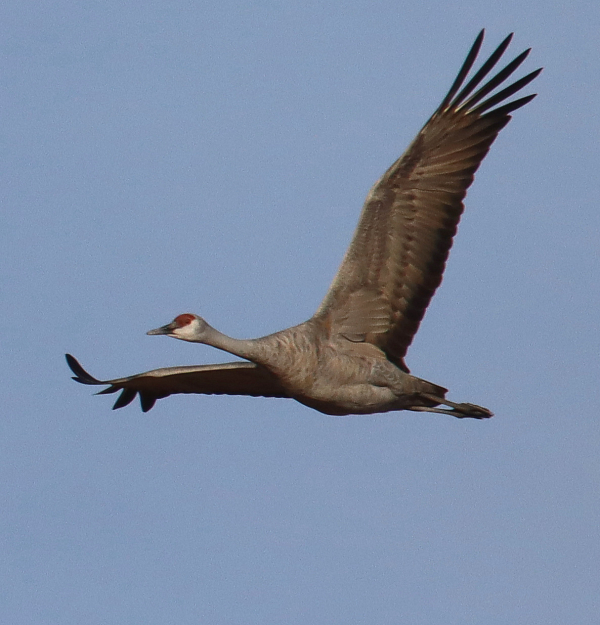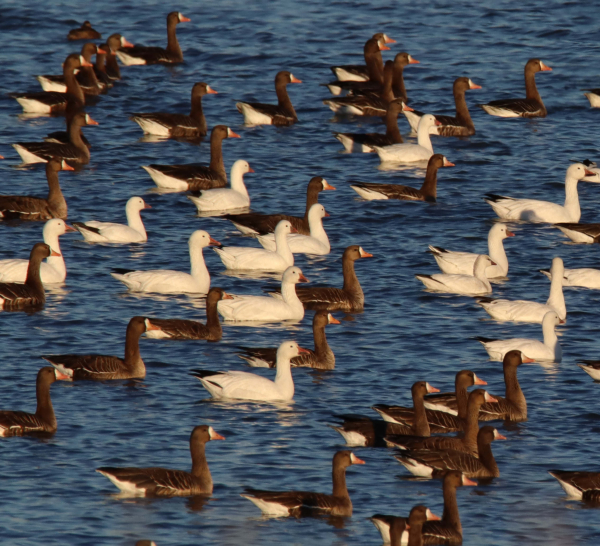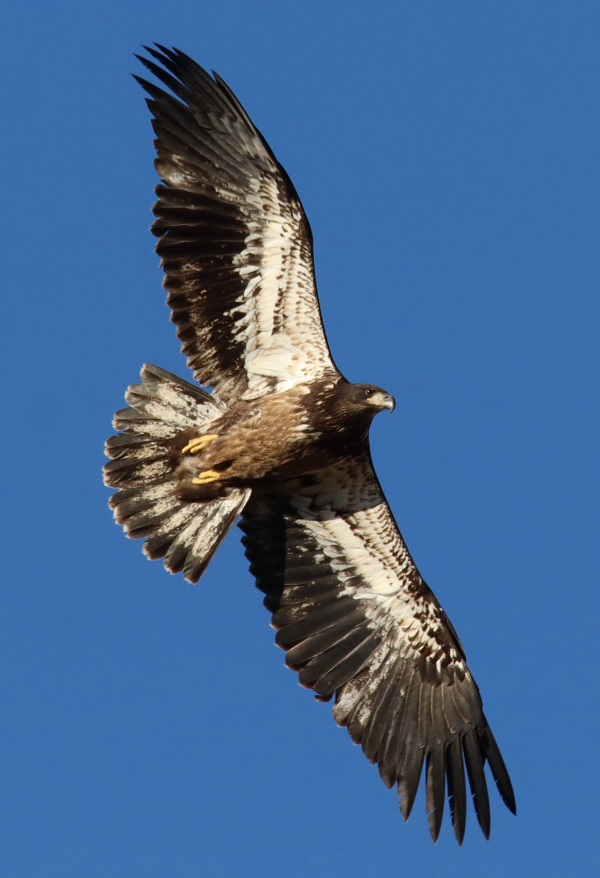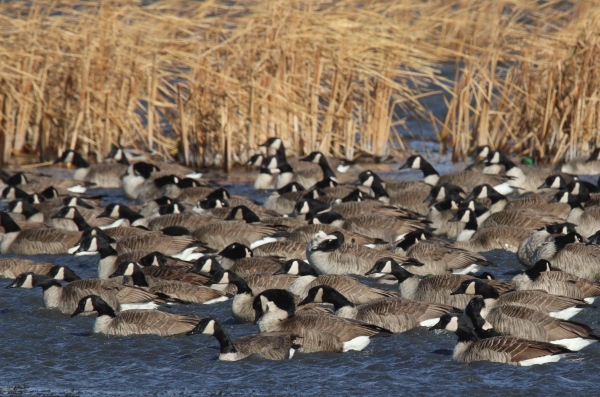
Sandhill Cranes fueled 2 birding trips to Long Lake National Wildlife Refuge last week, although many other birds were present.

Evident along the edge of Snow and Ross’s Goose concentrations, large flocks of White-fronted Geese were most obvious among the new migrants to the Coteau region.

A first-fall Bald Eagle banked in soaring flight into bright afternoon sunlight on the edge of Long Lake Refuge.

During an intense wind storm Sunday, a mixed flock of Canada and Cackling Geese sheltered behind a stand of cattails (note the reaction of the cattails to the wind).
|
Sandhill Cranes fueled my birding activities the first days of November, which also revealed an impressive increase in waterfowl, especially geese, detected while driving the same 2 hour route 2 days apart. A north wind clearly brought thousands of new birds into the Missouri Coteau on Day 2 when large flocks of White-fronted Geese propelled the biggest change, with Snow Geese doubling and tripling in numbers, and Tundra Swans more obvious. It all started last Wednesday when I drove to Long Lake National Wildlife Refuge to try for better photos of Sandhill Cranes.
I arrived an hour before the previous Wednesday when I was concentrating on the Whooping Crane family, hoping to beat the Sandhills’ flight from their shallow-water roost site to a feeding area, and found the flight on-going by the time I arrived, with most of the 200 Sandhills already feeding in a harvested field adjacent to the refuge. I positioned in a location where I could photograph the cranes as they approached the feeding flock, and reveled at the chance to be surrounded by crane music. Small flocks of cranes tended to fly toward my position, then veer slightly to the right or left, flying low nearby and illuminated by ample sunlight for photos.
Flocks varied from 6 to 22, but the flights ended all too soon; so after a lengthy wait I decided to check on other potential crane locations in and adjacent to the refuge. A half-hour later I found a large flock of Sandhills feeding in a harvested wheat field – better yet, scattered pairs and groups of cranes were actively dancing on the edges of the flock. I pulled over and began trying to document dancing cranes, which continued and seemed to spread across the considerable acreage with cranes – bowing, jumping with spread wings, flapping, twisting, calling – how fun!
That was an exciting culmination to my initial 2-hour drive that started with a Prairie Falcon sighting about 15 miles west of my office. It was positioned adjacent to a big concentration of geese and ducks, which may have been coincidence, or not. There were 5 big flocks of geese along the way to Long Lake Refuge, each dominated by hundreds of Snow Geese, and at 3 of these waterfowl extravaganzas there were groups of Tundra Swans, numbering 12, 21, and about 120 – all far from approachable, swimming in the center of distant waters. Along the way I was surprised to see 3 Cattle Egrets, a rare sighting in the Coteau this year, and the dominant ducks were Northern Shovelers along with Green-winged Teal and Mallards. There were also 10 Ring-necked Pheasants in 4 groups.
An adult Bald Eagle provided a wild observation when I arrived at the refuge as it flew over the biggest flock of geese, flushing hundreds in response to the eagle’s flight, but they quickly settled back onto the water after the raptor passed. The other raptor of the day was a first-fall Harlan’s Red-tailed Hawk, a dark morph bird that showed a spotted underside, which was quite different from most Harlan’s I see. I had a close view as it seemed to fly directly to my position, then check me out as it hung low in the wind while I photographed it full-frame. It was surprising there were no other Red-tails or Northern Harriers along my route, but that was a sign of the season – the Harlan’s from Alaska was here, but most other hawks have moved through.
Rerun Friday
Geared up for another try to photograph more Sandhill Cranes in fine fall weather Friday, it was quickly obvious the change to a north wind the previous day and night brought thousands of new waterfowl into the Missouri Coteau, with White-fronted Geese most obvious in significantly larger flocks, along with expansive flocks of Snow and Ross’s Geese, plus more Cackling Geese and Tundra Swans. The big mixed flock of geese just 2 miles north of home essentially doubled in numbers overnight, and driving the same 2-hour route to Long Lake Refuge, there were 7 big concentrations of geese dominated by Snow Geese, with 5 flocks of Tundra Swans numbering 5, 12, 6, 4, and 40.
A late male American Kestrel was a surprise, and while there were no Red-tails to be seen, there were 2 first-fall Northern Harriers, 1 at the refuge. Other refuge raptors included 3 Bald Eagles, including 1 first-fall Bald that flew my way. Usually getting out of a vehicle will scare birds, but I needed to get out to follow the eagle’s flight through my camera lens. As I zoomed in on the young eagle, a big female, she began circling into a soaring flight – perfect for me to photograph as it steeply banked into the sun to show the varied coloration of its underside.
Arriving at the refuge mid-afternoon, it was immediately obvious the numbers of geese had at least tripled in number, with a few thousand present in 2 big flocks. Long Lake was also now holding big flocks of White-fronted Geese, mostly segregated near Canadas or on the edge of the big flocks of Snows. There were about 25 Tundra Swans in 2 groups on the refuge, with continuing large flocks of feeding Northern Shovelers and lots of Green-winged Teal and Mallards scattered around. An outlier among the waterfowl was a lone Western Grebe, and I also counted 22 Ring-necked Pheasants in 4 groups.
As for Sandhill Cranes, Friday they were noticeably out of sight – or had they migrated on the previous day’s north wind? With none showing up at the locations where I sighted them before, I finally found a big flock of about 500 Sandhills on a roost site. It was exciting to imagine so many cranes flying out in flocks to a feeding area soon, but the Sandhills were not on a buffet schedule and never left the roost that afternoon. I did have a chance to photograph a few flocks that returned to one of the fields I found them 2 days earlier, but where there were about 200 feeding Wednesday, only about 35 arrived Friday. Sandhill flocks are usually more predictable, so I was a bit taken aback by the Long Lake cranes. Even so, was great fun to see the numbers of Sandhills on the roost site, and to hear their familiar calls wherever I encountered them.
Local Action
Saturday a cold south wind kept birds from leaving, and I was excited to find 68 Tundra Swans with several hundred White-fronted Geese just a mile northeast of my office. There have been a half-dozen swans present for a couple weeks in the vast lake, but my jaw dropped when I saw the new arrivals feeding and resting when I checked the location that afternoon. The tight flock of White-fronts looked visibly exhausted, almost all resting their head on their back; perhaps they migrated in overnight from a stagging area in southern Saskatchewan or the northern part of the state.
Also noticeable was the increase in geese 2 miles north of my office, where the biggest flock in the area increased to more than 3,000 geese, including 5 species – mostly Snow and Ross’s Geese, then White-fronts and a mix of Canada and Cackling Geese.
Sunday was one of the most unusual weather days I’ve experienced, with 40mph winds with gusts up to 65mph creating a “corn blizzard,” fueled by the leaves and chaff from newly harvested corn fields nearby and corn actually formed “corn drifts” a few feet high in many area locations. These conditions dampened waterfowl action that morning, but during a local afternoon survey I found an interesting location where a small mixed flock of geese was sheltering from the wind in a shallow bay behind a wall of cattails. Mostly made up of Canada Geese, there were a few Cackling Geese with them and a couple White-fronts, along with a scattering of Mallards. After I slipped into position to photograph without concerning the resting geese, a small flock of Ross’s and Snow Geese flew in to land among the others.
Less than a mile south of this location and less than a mile north of home, a huge mixed flock of geese assembled in a harvested corn field, providing some impressive views as aerial flocks lined up to land among the feeding Snows and White-fronts. Two miles south of home I found what must have been one of the last remaining Red-tailed Hawks in the state, and as I returned home, about the same location I sighted a flock of 6 Tundra Swans flying southwest. I followed the swans flight from a distance, hoping for the chance to intercept them for a photo op.
They were always at least a half-mile away but after I had a chance to turn west, they slowed to consider landing in a lake, breaking into 3 pairs and winging low, but after passing them and turning north to utilize the light of the soon to be setting sun, a pair of swans elevated above the water and flew in my direction, providing me with a chance to take a few precious photos as they winged westward. The other pairs followed, but weren’t positioned right for photos; you can see the best of the Tundra Swan photos at the end of the Bird Photography feature, along with other photos I took last week.
The Yardbirds
The stunning color of a male Purple Finch surprised me Saturday afternoon, but it turned out that its repeated visits to my feeding station and bird bath was the beginning of an interesting parade of new and continuing birds while I was working on this issue. Next, a pair of American Goldfinches interrupted me – that’s a good thing, especially considering I haven’t seen a goldfinch at my feeders for months. And as I took a few photos of the goldfinches, a trio of Hairy Woodpeckers assembled – a really rare sighting to see such a group after the fledging period. Even so, at least one of the Hairys seemed to be a young bird as indicated by its actions and its seeming unfamiliarity to feeders. (I included photos from the above sightings in the Backyard Birding article in this issue.)
As many as 3 Blue Jays assembled at my feeding station, and there seems to be just 1 Dark-eyed Junco and a solo Harris’s Sparrow continuing to show up day after day. Then, to usher in Saturday evening, in the dim light of dusk I noticed a small nuthatch at my suet feeder – no there were 2; yes, 2 Red-breasted Nuthatches found my feeding station just before dark. Were they new migrants that started their flight earlier in the afternoon, or were they in the area throughout the day and just zeroed in on my feeding station late? Regardless, there have been at least 2 around ever since. White-breasted Nuthatches and Downy Woodpeckers continue to be favorite visitors, and I expect they will be here at least into May. The big questions are, what other birds will visit, when will they arrive, and how long will they stay – there’s a big change a comin’.
Big Change
It’s that time of year when a big change is comin’: Last Wednesday we had a high temperature of 75 degrees, a day later the high was 45, and Monday the high temperature was 25 – Yikes! Monday I was surprised to see the shallow marshes in the area were all topped by ice, always a day of reckoning, and it snowed for about an hour to lend an artistic wind-blown pattern atop the ice. But my melancholy came from the shift of birds to the deeper lakes, probably forcing the last shorebirds and wading birds south among others.
It also means birds from the north will be pressed to head this way, and I’m hoping the 3,000 geese in the area will expand to 30,000 soon, and eventually swell to more than 300,000! Happens most years; but checking the weather forecast the bottom could drop out on late November waterfowl observations. This Thursday and Friday we are bracing for a big snowstorm, and temperatures could drop below zero by Monday. Next weekend could be a wild ride for birds in this area, and for this birder – I’m hoping for the best, and I’m wishing you a week of memorable birding opportunities at home, locally, and beyond – November is an exciting month of seasonal change.
Article and photos by Paul Konrad
Share your bird sightings and photographs at editorstbw2@gmail.com